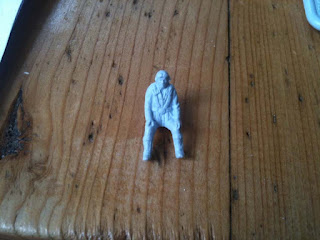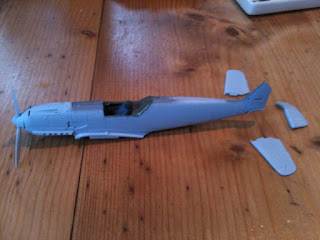View from the Leas venue terrace. Weather was nice! [1]
Having become somewhat more of a model builder than a figure collector/painter in recent months, when a pal suggested a trip to Folkestone for Euro Militaire, 2016, I said 'yes please'.
A nice model of the German's Mickey 'Maus' tank. [2]
As something of a Boney-phile I like that their logo is a portrait of the man himself. But, although there were a good deal of Napoleonic subjects on display in the competition and display areas, there was very little of that era for sale in a form I felt tempted by.
I did buy an MB 54mm Hussar at the last Salute I went to, and a few stalls had the figures from that range, but I was determined to try and remain 'on track' and 'on scale'! There was one guy with a lot of mostly second-hand models, who had some vintage Airfix Napoleonics in 54mm, the nostalgia value of which tempted me. But I thought they were a bit pricey... and then I ran out of money anyway!
My buddy said the show was a lot smaller than the last time he went, and that he heard one of the organisers muttering about how Brexit might've discouraged some of our continental brethren (and sistren!) from making the trip this year.
F-F-F-Folkestone's f-f-f-famous f-f-f-funicular lift. Powered by water and gravity, so I was told.
My buddy said the show was a lot smaller than the last time he went, and that he heard one of the organisers muttering about how Brexit might've discouraged some of our continental brethren (and sistren!) from making the trip this year.
That'd be a terrible and ironic shame if it were true, as, just as the name of the show itself suggests, this is an instance of UK folk being friendly and welcoming to the idea of internationalism, at least as far as the near continent is concerned.
The truth of the matter for me is that, despite greatly admiring what modeller's do in larger scales, single figures, and realms such as fantasy, etc., I'm really much more of a dyed-in-the-wool small scale historical guy; I like masses of troops and tanks, based on real conflicts.
So, although I admired much of what was on display - it's stunning, frankly, so how can one not be bowled over? - nevertheless, my chief concern was to acquire some small scale armour and figures.
In the end, however, I bought mostly planes! This might partly be the influence of the buddy with whom I travelled, Paul Crossman, who's primarily been making 1/72 planes in recent years. But it's also been influenced by films I've watched - from 12 O'Clock High to the Battle of Britain - and books I've been reading.
My swag from the show!
In both Hitler's Soldiers and The War In The West, the role of the Luftwaffe was looked at in some detail, the latter title devoting a fair chunk to the way in which Germany's air-arm's supremacy was crucial to both their initial victories in Poland and France, and subsequent extensions of conquest such as Norway and Greece and the Balkans.
Even though the Battle of Britain was both short and relatively small scale, it was clearly crucial in stopping Hitler gambling on invading Britain, and thus knocking out the last West-European adversary he had failed to either conquer or otherwise neutralise. Anyway, all this got me more and more interested in buying and building model planes to add to my growing 1/72 WWII collection.
Up until the weekend of Euro Militaire, this had been a very small scale and sporadic development, with as many WWI aircraft winging their way to my worktable as WWII machines. Then I bought and built a Spitfire and Messerschmit on our recent short summer breaks - at the time I was reading the Battle of Britain segment of The War In The West - and that's when the bug really bit!
Then, whilst shopping with Teresa in Ely, I spotted a Battle Of Britain 75th anniversary set by Airfix, reduced from £45 (a bit overpriced!) to £30, and snapped it up. Despite knowing I was off to Euro-Militaire the very next day!
And at the show itself, I found that - whilst there was tons to gawp at in admiration - most the traders weren't selling stuff geared to my particular and quite narrow current interests. Indeed, there were only three stalls that had the sort of things I was after. One of these had tons of stuff that I liked the look of, and I promptly spent all my remaining cash on a stash of mostly German WWII aeroplanes.
One of only two vehicle purchases of the show!
One of the other stalls (Mr. Models, I think?), from whom I'd made my first purchases of the day - more WWII German planes! - would've had a lot more of my money, if their card-machine had worked. Perhaps I ought to be grateful it didn't?
In the end I only bought two vehicles, and both of those were a bit off my usual map, being as one was a Russian fuel-tanker truck (see above pic.), and the other a German bus. Figure-wise I got a pack of Zvezda 1/72 German HQ figures, plus a big box of Airfix soft-plastic Luftwaffe figures, inc. both pilots and ground crew, and another Zvezda set, also of Luftwaffe ground-crew.
In the end I only bought two vehicles, and both of those were a bit off my usual map, being as one was a Russian fuel-tanker truck (see above pic.), and the other a German bus. Figure-wise I got a pack of Zvezda 1/72 German HQ figures, plus a big box of Airfix soft-plastic Luftwaffe figures, inc. both pilots and ground crew, and another Zvezda set, also of Luftwaffe ground-crew.
Very nice figures. Just a shame there aren't a lot more of them.
Plenty of figures. But not so nicely posed, and poses are repeated too much for my liking.
I had hoped someone at the show might stock the Preiser 1/72 Luftwaffe ground crew figures. But I couldn't find anyone selling their ranges. Of the two sets I purchased, the Zvezda are much better sculpted, and being hard plastic are also easier to work with if converting (not that they need it!). But they are also a lot more expensive.
The Airfix Luftwaffe groundcrew, although described on the box as 1/72, are much smaller than the Zvezda figures. Are they actually 1/76, simply re-boxed/-branded as 1/72? The repeated poses mean many figures are either going to be redundant, or will require some conversion.
The Airfix Luftwaffe groundcrew, although described on the box as 1/72, are much smaller than the Zvezda figures. Are they actually 1/76, simply re-boxed/-branded as 1/72? The repeated poses mean many figures are either going to be redundant, or will require some conversion.
I have converted soft plastic figures before, with what appeared at the time (to me!) to be both ease and success. This set is going to tax those skill rather more, methinks!
My 1st conversion attempt with the Airfix LW figs:
My 1st conversion attempt with the Airfix LW figs:
Paul advised me to 'pin' my conversion parts. [3]
The toolbox carried at a more realistic angle.
----------
NOTES:
[1] I was told that on a clear day you can see France. When I was told this, the far horizon was shrouded in a heat-haze. But when Paul took this pic, it looked a lot clearer. Somewhat to my chagrin, however, I still couldn't quite make out the French coast.
[2] I only took my iPhone, camera-wise, and that wouldn't let me take many pics (even with me deleting loads!). So I only got two or three pretty poor pics. This one is one of them.
[3] Last time I did plastic figure conversions I just cut and superglued, and it seems to have worked OK. Pinning is a lot more fiddly. I hope it also proves to be sturdy!?
[2] I only took my iPhone, camera-wise, and that wouldn't let me take many pics (even with me deleting loads!). So I only got two or three pretty poor pics. This one is one of them.
[3] Last time I did plastic figure conversions I just cut and superglued, and it seems to have worked OK. Pinning is a lot more fiddly. I hope it also proves to be sturdy!?



















































